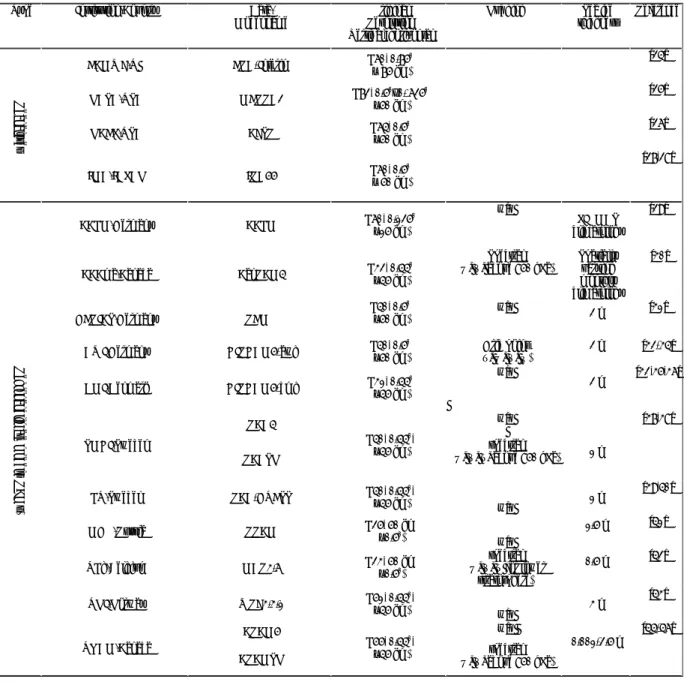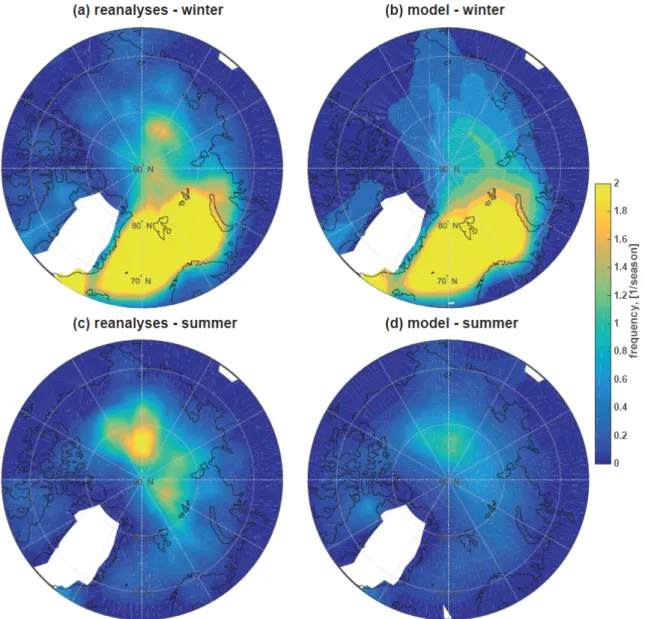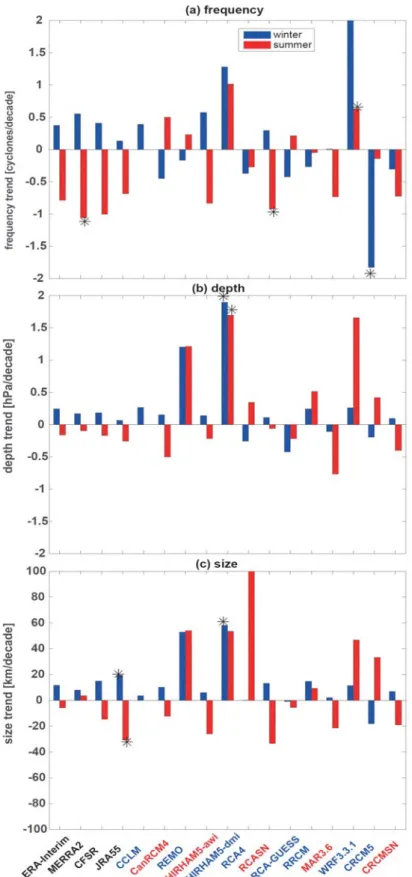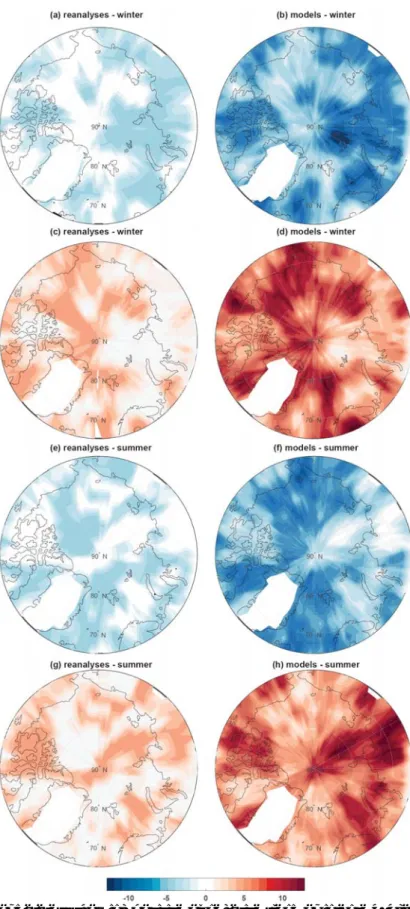IOP Conference Series: Earth and Environmental Science
PAPER • OPEN ACCESS
Trends of intense cyclone activity in the Arctic from reanalyses data and regional climate models (Arctic-CORDEX)
To cite this article: M Akperov et al 2019 IOP Conf. Ser.: Earth Environ. Sci. 231 012003
View the article online for updates and enhancements.
Content from this work may be used under the terms of theCreative Commons Attribution 3.0 licence. Any further distribution of this work must maintain attribution to the author(s) and the title of the work, journal citation and DOI.
Published under licence by IOP Publishing Ltd
Turbulence, Atmosphere and Climate Dynamics
IOP Conf. Series: Earth and Environmental Science 231 (2019) 012003
IOP Publishing doi:10.1088/1755-1315/231/1/012003
1
Trends of intense cyclone activity in the Arctic from reanalyses data and regional climate models (Arctic- CORDEX)
M Akperov1, A Rinke2, I I Mokhov1,3, H Matthes2, V A Semenov1,4, M Adakudlu5, J Cassano6, J H Christensen5,7, M A Dembitskaya1, K Dethloff2, X Fettweis8, J Glisan9, O Gutjahr10, G Heinemann11, T Koenigk12, N V Koldunov13,14, R Laprise15, R Mottram16, O Nikiéma15, M Parfenova1, J F Scinocca17, D Sein14, S Sobolowski5, K Winger15 and W Zhang18, 19
1A.M. Obukhov Institute of Atmospheric Physics, RAS, Moscow, Russia
2Alfred Wegener Institute, Helmholtz Centre for Polar and Marine Research, AWI, Potsdam, Germany
3Lomonosov Moscow State University, Moscow, Russia
4Institute of Geography, RAS, Moscow, Russia
5Uni Research Climate, Bjerknes Centre for Climate Research, Bergen, Norway
6Cooperative Institute for Research in Environmental Sciences and Department of Atmospheric and Oceanic Sciences, University of Colorado, Boulder, United States
7University of Copenhagen, Niels Bohr Institute, Denmark
8Department of Geography, University of Liège, Belgium
9Iowa State University, United States
10Max Planck Institute for Meteorology, Hamburg, Germany
11Environmental Meteorology, Faculty of Regional and Environmental Sciences, University of Trier, Germany
12Rossby Centre, Swedish Meteorological and Hydrological Institute, 60176
Norrköping, Sweden and Department of Meteorology, Bert Bolin Centre for Climate Research, Stockholm University, 10654 Stockholm, Sweden
13MARUM - Center for Marine Environmental Sciences, Bremen
14Alfred Wegener Institute, Helmholtz Centre for Polar and Marine Research, AWI, Bremerhaven, Germany
15Centre ESCER, Université du Québec à Montréal, Montréal, Québec, Canada
16Danish Meteorological Institute, Copenhagen, Denmark
17Canadian Centre for Climate Modelling and Analysis, Environment and Climate Change Canada, Victoria, British Columbia, Canada
18Department of Physical Geography and Ecosystem Science, Lund University, 22362, Lund, Sweden
19Center for Permafrost (CENPERM), Department of Geosciences and Natural Resource Management, University of Copenhagen, Copenhagen, Denmark E-mail: Mirseid Akperov (aseid@ifaran.ru)
Abstract The ability of state-of-the-art regional climate models (RCMs) to simulate the trends of intense cyclone activity in the Arctic is assessed based on an ensemble of 13 simulations from 11 models from the Arctic-CORDEX initiative. Some models employ large-scale spectral nudging techniques. Cyclone characteristics simulated by the ensemble in winter and summer are compared with the results from four reanalyses (ERA-Interim, NCEP-CFSR, NASA- MERRA2 and JMA-JRA55) in winter and summer for 1981-2010 period.
Turbulence, Atmosphere and Climate Dynamics
IOP Conf. Series: Earth and Environmental Science 231 (2019) 012003
IOP Publishing doi:10.1088/1755-1315/231/1/012003
1. Introduction
Cyclones play a key role in the changing of Arctic climate system, in particular contributing to the meridional atmospheric heat and moisture transport from mid-latitudes into the Arctic, thereby changing cloud feedbacks with impacts on the sea ice retreat in a warming climate [1-8]. An example was the destruction of sea ice by the intense Arctic cyclone that occurred in summer 2012 contributing to the record low sea ice minimum in that September [9]. Thus, cyclones, in particular, intense cyclones, are a key component of the Arctic climate system and the understanding of their role in Arctic climate change is an important task.
The aim of this study is to assess the performance of Arctic Coordinated Regional Downscaling Experimen (CORDEX) regional climate models (RCMs) with respect to ensemble of four state-of-art reanalysis products to represent the trends of intense cyclone activity in the Arctic.
2. Data and Methods
We analyze cyclone characteristics obtained from 6-hourly mean sea level pressure (MSLP) data from an ensemble of 13 atmospheric RCMs simulations and four reanalysis products (Table 1) during the 1981–2010 period for the Arctic region (north of 65°N) for two seasons – winter (DJF) and summer (JJA).
The four reanalyses products used are ERA-Interim, NCEP-CFSR, NASA-MERRA2 , and JMA- JRA55, hereafter called ERA-Interim, CFSR, MERRA2, and JRA55 (Table 1). The 13 Arctic- CORDEX RCM simulations (Table 1) are based on the standard Arctic CORDEX model setup (http://climate-cryosphere.org/activities/targeted/polar-cordex/arctic). The domain and the horizontal resolution is nearly the same (rotated 0.44 deg. x 0.44 deg. grid, 116 x 133 grid points) for all models.
Only the CCLM model applies a higher resolution (15 km), but data is only available for the winter season. The key model and reanalyses information are presented in Table 1, and we refer to [10]. For the analysis, the reanalyses have been regridded onto the Arctic-CORDEX grid.
We use an algorithm of cyclone identification similar to [11,12] with some modifications for the Arctic region [10,13,14]. The algorithm is based on the MSLP field and has been shown to be useful to investigate the changes in cyclone activity in extratropical and high latitudes [13,15-18].
We calculate cyclone frequency, depth and size. The cyclone frequency is defined as the number of cyclone events per season. To map spatial patterns of cyclone characteristics we use the grid with circular cells of a 2.5° latitude radius.
We consider cyclone depth as a measure of cyclone intensity. The cyclone depth is determined as a difference between the minimum central pressure in the cyclone and the outermost closed isobar.
As shown in previous studies [19,20], the depth provides a direct measure of the kinetic energy of the system. Deep cyclones are identified by anomalously strong depth exceeding an arbitrary threshold chosen to be the 95th percentile of cyclone depth distribution from all reanalyses, which corresponds to ca. 20 hPa. The cyclone size (radius) is determined as the average distance from the geometric center to the outermost closed isobar.
Trends have been calculated based on linear least-squares regression. As an indicator of the robustness of any trend, we calculate their statistical significance using a Student’s t-test at the 90%
confidence level (P < 0.1).
3. Results
Figure 1 displays the climatology of intense cyclone frequency for winter and summer from multi- reanalyses and the multi-model means for the period 1981-2010. The multi-model ensemble mean realistically reproduces the spatial pattern of intense cyclone frequency in the Arctic as compared to multi-reanalyses data for both seasons. In winter, maxima of intense cyclone frequency occur over the Arctic North Atlantic and Barents Sea. Compared to winter, the intense cyclone frequency in summer is much lower and the maximum is shifted to the central Arctic Ocean. These seasonal characteristics have been discussed in previous studies [10,21-23].
Turbulence, Atmosphere and Climate Dynamics
IOP Conf. Series: Earth and Environmental Science 231 (2019) 012003
IOP Publishing doi:10.1088/1755-1315/231/1/012003
3
Table 1. Reanalyses and Arctic CORDEX models, and their corresponding information where U – zonal wind, V – meridional wind, T – temperature, Q - humidity. w/o – without nudging.
Type Institution/Country Data/
Model name
Original Resolution Vertical, horizontal
Nudging Sea ice thickness
Reference
ECMWF/UK ERA-Interim L60, 0.750 (~ 75 km)
[24]
NASA/USA MERRA2 L72, 0.50x0. 6250 (~50 km)
[25]
NCEP/USA CFSR L64, 0.50
(~50 km)
[26]
Reanalyses
JMA/JAPAN JRA55 L60, 0.50
(~ 50 km)
[27,28]
CCLM/Germany CCLM L60, 0.1250 (~15 km)
w/o PIOMAS climatology
[29]
CCCma/Canada CanRCM4 L32, 0.440 (~45 km)
Spectral
(U, V, above 850 hPa) Spatially varying monthly climatology
[30]
GERICS/Germany REMO L40, 0.50
(~50 km) w/o 2 m [31]
AWI/Germany HIRHAM5-awi L40, 0.50 (~50 km)
Grid point (T, U, V, Q)
2 m [32-34]
DMI/Denmark HIRHAM5-dmi L31, 0.440 (~45 km)
w/o 2 m [32,35,36]
RCA4 w/o
SMHI/Sweden
RCASN
L40, 0.440,
(~45 km) spectral
(U, V, T, above 850 hPa) 1 m
[37,38]
LU/Sweden RCA-GUESS L40, 0.440,
(~45 km) w/o
1 m [39,40]
MGO/Russia RRCM L25, 50 km
(~0.50) w/o
1.5 m [41]
ULg/Belgium MAR3.6 L23, 50 km (~0.50)
spectral (U, V, T for lower
stratosphere)
0.5 m [42]
UNI/Norway WRF3.3.1 L51, 0.440,
(~45 km) w/o 3 m [43]
CRCM5 w/o
Regional climate models (RCMs)
UQAM/Canada
CRCMSN
L55, 0.440,
(~45 km) spectral (U, V, above 850 hPa)
0.001-2.5 m [44-46]
Turbulence, Atmosphere and Climate Dynamics
IOP Conf. Series: Earth and Environmental Science 231 (2019) 012003
IOP Publishing doi:10.1088/1755-1315/231/1/012003
Figure 1. Spatial distribution of intense cyclone frequency in winter (c, d) and summer (c, d) from multi-reanalyses and multi-model ensemble, 1981-2010.
The analysis of the 30-yr (1981-2010) linear trends of intense cyclone frequency shows that almost half of the RCMs (7 out of 13 in winter, and 7 out of 12 in summer) simulate a decrease for winter and summer, but these trends are not statistically significant (fig. 2a). The other half show the reverse trend sign. At the meantime, the reanalyses show a consistent increase in winter and decrease in summer.
Importantly, an increase of intense cyclone frequency in winter is observed for 2 out of 5 models with spectral nudging [47]. In summer, even 4 out of 5 models with spectral nudging demonstrate the same behaviour of the decreasing trend as in reanalyses. This finding supports that a nudging procedure is useful to represent the cyclone activity in models more realistically [10].
All reanalyses show consistent trends for the mean depth of intense cyclones (fig. 2b), with an increase in winter and a decrease in summer. Adequately, most models (9 out of 14) show an increase in winter. However, in summer, half of the models show an increase, the other half an decrease of cyclone depth. But, again, nudged model runs show a higher skill. 4 out of 5 nudged models show the same trend as the reanalyses for both seasons. Most unnudged models show different trend signs. The same trend
Turbulence, Atmosphere and Climate Dynamics
IOP Conf. Series: Earth and Environmental Science 231 (2019) 012003
IOP Publishing doi:10.1088/1755-1315/231/1/012003
5
Figure 2. 30-year trends (1981-2010) of intense cyclone frequency (a), depth (b) and size (c) from reanalyses and models in winter (blue) and summer (red), averaged over the Arctic (north of 65˚N). An
asterisk indicates a significant trend at the 90%-level. The names of the different datasets on the x-axis are highlighted by color (black – reanalyses, red – nudged models, blue – non-nudged models).
Turbulence, Atmosphere and Climate Dynamics
IOP Conf. Series: Earth and Environmental Science 231 (2019) 012003
IOP Publishing doi:10.1088/1755-1315/231/1/012003
Figure 3. Number of datasets showing positive or negative trend of intense cyclone frequency (1981- 2010) in winter (a-d) and summer (e-h). The color scale represents the number of reanalyses and models with a positive (red colors) and negative (blue colors) trends. 4 reanalyses and 13 models have
been used.
Turbulence, Atmosphere and Climate Dynamics
IOP Conf. Series: Earth and Environmental Science 231 (2019) 012003
IOP Publishing doi:10.1088/1755-1315/231/1/012003
7
behaviours are shown for intense cyclone size (fig. 2c). As shown previously [14], mostly deep (intense) cyclones are associated with a large size. It should be also noted that most trends are statistically non-significant.
Figure 3 shows the large agreement among the reanalyses, among the models and between the reanalyses and models in the spatial trend patterns of intense cyclone frequency in both seasons. In winter, they show an increase over the Beaufort Sea, Chukchi Sea, Greenland Sea, and East-Siberian Sea, and a decrease over the Arctic Ocean, Barents- and Kara Seas, Baffin Bay and continents. In summer, they agree on an increase over the Barents Sea, Kara Sea and part of Laptev Sea and over most of the continents, and a decrease over the most parts of Arctic Seas.
4. Summary and Conclusion
The ability of the regional climate models participating in the Arctic-CORDEX to simulate the intense cyclone activity in the Arctic region have been assessed in comparison with reanalyses data. The regional models accurately reproduce the spatial distribution of intense cyclone frequency as well as of the characteristics (cyclone depth and size), when compared to reanalysis data.
The reanalyses show consistent trends for the intense cyclone frequency and mean depth and size of intense cyclones, with an increase in winter and a decrease in summer. Models with spectral nudging can reproduce the same trend as in reanalyses for both seasons, while models which do not apply any nudging show often deviating trend signs compared to the reanalyses. However, the model ensemble largely agree with the reanalyses on the key regional trend patterns.
Acknowledgements
M.A., I.I.M., V.A.S., M.P, M.A.D., A.R., K.D. acknowledge the support by the project “Quantifying Rapid Climate Change in the Arctic: regional feedbacks and large-scale impacts (QUARCCS)” funded by the German and Russian Ministries of Research and Education (project №14.616.21.0078 (RFMEFI61617X0078)).We acknowledge the Japan Meteorological Agency (JMA) for providing JRA-55, the European Centre for Medium- Range Weather Forecasts (ECMWF) for providing ERA- Interim, the National Centers for Environmental Prediction (NCEP) for providing NCEP-CFSR, NASA Goddard Earth Sciences (GES) Data and Information Services Center (DISC) for providing MERRA2 and Polar meteorology group for providing ASR reanalysis. Data from reanalyses were retrieved from https://reanalyses.org/atmosphere/overview-current-atmospheric-reanalyses/.
References
[1] Mokhov I I, Mokhov O I, Petukhov V K and Khayrullin R R 1992 Effect of global climatic changes on the cyclonic activity in the atmosphere. Izv. Atmos. Oceanic Phys. (Izv. Akad.
Nauk, Fiz. Atmos. Okeana) 28(1) 7-18
[2] Mokhov I I, Mokhov O I, Petukhov V K and Khayrullin R R 1992 Cloud effect on the atmospheric eddy activity at climate change. Rus. Meterol. Hydrol. 1 1-6
[3] Mokhov I I et al. 1994 Extratropical cyclones and anticyclones: Tendencies of change. In: The Life Cycles of Extratropical Cyclones. Vol. II. Ed. By S. Grohas and M.A. Shapiro. Bergen, Geophysical Institute, University of Bergen 56-60
[4] Mokhov I I, Chernokul’skii A V, Akperov M G, Dufresne J-L and Treut H Le 2009 Variations in the characteristics of cyclonic activity and cloudiness in the atmosphere of extratropical latitudes of the Northern Hemisphere based from model calculations compared with the data of the reanalysis and satellite data Dokl. Earth Sci. 424(1) 147–150
[5] Akperov M G and Mokhov I I 2013 Estimates of the sensitivity of cyclonic activity in the troposphere of extratropical latitudes to changes in the temperature regime Izv. Atmos.
Ocean. Phys. 49(2) 113–120
[6] Boisvert L N, Petty A A and Stroeve J C 2016 The Impact of the Extreme Winter 2015/16 Arctic Cyclone on the Barents–Kara Seas Mon. Weather Rev. 144(11) 4279–87
Turbulence, Atmosphere and Climate Dynamics
IOP Conf. Series: Earth and Environmental Science 231 (2019) 012003
IOP Publishing doi:10.1088/1755-1315/231/1/012003
[7] Rinke A, Maturilli M, Graham R M, Matthes H, Handorf D, Cohen L, Hudson S R and Moore J C 2017 Extreme cyclone events in the Arctic: Wintertime variability and trends Environ. Res.
Lett., 12(9)
[8] Yamagami A, Matsueda M and Tanaka H L 2017 Extreme Arctic cyclone in August 2016 Atmos. Sci. Lett. 18(7) 307–314
[9] Simmonds I and Rudeva I 2012 The great arctic cyclone of August 2012 Geophys. Res. Lett.
39(10) 1–6
[10] Akperov M, Rinke A, Mokhov I I, Matthes H, Semenov V A, Adakudlu M et al. et al. 2018 Cyclone activity in the Arctic from an ensemble of regional climate models (Arctic CORDEX) J. Geophys. Res. 123 2537-54
[11] Bardin M Y and Polonsky A B 2005 North Atlantic oscillation and synoptic variability in the European- Atlantic region in winter Izv. Atmos. Ocean. Phys. 41(3) 127–136
[12] Akperov M G, Bardin M Y, Volodin E M, Golitsyn G S and Mokhov I I 2007 Probability distributions for cyclones and anticyclones from the NCEP/NCAR reanalysis data and the INM RAS climate model Izv. Atmos. Ocean. Phys. 43(6) 705–712
[13] Akperov M, Mokhov I I, Rinke A, Dethloff K and Matthes H 2015 Cyclones and their possible changes in the Arctic by the end of the twenty first century from regional climate model simulations Theor. Appl. Climatol. 122(1–2), 85–96
[14] Zahn M, Akperov M G, Rinke A, Feser F and Mokhov I I 2018 Trends of cyclone characteristics in the Arctic and their patterns from different re-analysis data J. Geophys. Res. 123 2737-51 [15] Akperov M G and Mokhov I I 2010 A comparative analysis of the method of extratropical
cyclone identification Atmos. Ocean. Phys. 46(5) 574–590
[16] Neu U et al. 2013 IMILAST: A community effort to intercompare extratropical cyclone detection and tracking algorithms Bull. Am. Meteorol. Soc. 94(4) 529–547
[17] Ulbrich U et al. 2013 Are Greenhouse Gas Signals of Northern Hemisphere winter extra-tropical cyclone activity dependent on the identification and tracking algorithm? Meteorol. Zeitschrift 22(1) 61–68
[18] Simmonds I and Rudeva I 2014 A comparison of tracking methods for extreme cyclones in the Arctic basin Tellus A 1(8) 1–13
[19] Golitsyn G S, Mokhov I I, Akperov M G and Bardin M Y 2007 Distribution functions of probabilities of cyclones and anticyclones from 1952 to 2000: An instrument for the determination of global climate variations Dokl. Earth Sci. 413(1) 324–326
[20] Simmonds I and Keay K 2009 Extraordinary September Arctic sea ice reductions and their relationships with storm behavior over 1979-2008 Geophys. Res. Lett. 36(19) 1–5
[21] Wernli H and Schwierz C 2006 Surface cyclones in the ERA-40 dataset (1958–2001). Part I:
Novel identification method and global climatology J. Atmos. Sci. 63 2486–2507
[22] Simmonds I, Burke C and Keay K (2008) Arctic Climate Change as Manifest in Cyclone Behavior J. Clim. 21(22) 5777–96
[23] Crawford A D and Serreze M C 2016 Does the summer arctic frontal zone influence arctic ocean cyclone activity? J. Clim. 29(13) 4977–93
[24] Dee D, Uppala S, Simmons A, Berrisford P, Poli P, Kobayashi S et al. 2011 The ERA-Interim reanalysis: configuration and performance of the data assimilation system Quarterly Journal of the Royal Meteorological Society 137(656) 553-597
[25] Gelaro R et al. 2017 The Modern-Era Retrospective Analysis for Research and Applications Version 2 (MERRA-2) J. Clim. 30 5419–54
[26] Saha S et al. 2010 The NCEP Climate Forecast System Reanalysis Bull. Amer. Meteor. Soc. 91 1015–57
[27] Ebita A et al. 2011 The Japanese 55-year Reanalysis ”JRA-55”: An Interim Report, SOLA 7 149–152
Turbulence, Atmosphere and Climate Dynamics
IOP Conf. Series: Earth and Environmental Science 231 (2019) 012003
IOP Publishing doi:10.1088/1755-1315/231/1/012003
9
[28] Kobayashi S, Ota Y, Harada Y, Ebita Y, Moriya M, Onoda H, Onogi K, Kamahori H, Kobayashi C, et al 2015 The JRA-55 Reanalysis: General Specifications and Basic Characteristics. J. Meteorol. Soc. Japan 93 5-48
[29] Gutjahr, O., Heinemann, G., Preußer, A., Willmes, S., and C. Drüe, (2016) Quantification of ice production in Laptev Sea polynyas and its sensitivity to thin-ice parameterizations in a regional climate model, Cryosph., 10, 2999-3019,doi: 10.5194/tc-2999-2016.
[30] Scinocca J, Kharin V, Jiao Y, M. Qian et al 2016 Coordinated Global and Regional Climate Modeling J. Clim. 29 17–35
[31] Sein D V, Koldunov N V, Pinto J G and Cabos W 2014 Sensitivity of simulated regional Arctic climate to the choice of coupled model domain Tellus, Series A: Dynamic Meteorology and Oceanography 66(1) 1–18
[32] Christensen O B, Drews M, Christensen J H, Dethloff K, Ketelsen K, Hebestadt I and Rinke A 2007 The HIRHAM Regional Climate Model Version 5 (β) DMI Technical report 06–17 [33] Sommerfeld A, Nikiema O, Rinke A, Dethloff K and Laprise R 2015 Arctic budget study of
intermember variability using HIRHAM5 ensemble simulations J. Geophys. Res. Atmos. 120, 9390–07
[34] Klaus D, Dethloff K, Dorn W, Rinke A, and Wu D L 2016 New insight of Arctic cloud parameterization from regional climate model simulations, satellite-based, and drifting station data Geophys. Res. Lett. 43 5450–59
[35] Lucas-Picher P, Boberg F, Christensen J H and Berg P 2013 Dynamical downscaling with reinitializations: a method to generate fine-scale climate data sets suitable for impact studies Journal of Hydrometeorology 14 1159–74
[36] Lucas-Picher P, Wulff-Nielsen M, Christensen J H, Aðalgeirsdóttir G, Mottram R, and Simonsen S B 2012 Very high resolution regional climate model simulations over Greenland:
Identifying added value J. Geophys. Res. Atmos. 117
[37] Berg P, Döscher R and Koenigk T 2013 Impacts of using spectral nudging on regional climate model RCA4 simulations of the Arctic Geosci. Model Dev. 6(3) 849–59
[38] Koenigk T, Berg P and Döscher R 2015 Arctic climate change in an ensemble of regional CORDEX simulations Polar Research 34 24603
[39] Smith B, Samuelsson P, Wramneby A and Rummukainen M 2011 A model of the coupled dynamics of climate, vegetation and terrestrial ecosystem biogeochemistry for regional applications Tellus, Ser. A Dyn. Meteorol. Oceanogr. 63(1) 87–106
[40] Zhang W, Jansson C, Miller P A, Smith B and Samuelsson P 2014 Biogeophysical feedbacks enhance the Arctic terrestrial carbon sink in regional Earth system dynamics Biogeosciences 11 5503-19
[41] Shkolnik I M and Efimov S V 2013 Cyclonic activity in high latitudes as simulated by a regional atmospheric climate model: added value and uncertainties Environ. Res. Lett. 8(4) 45007 [42] Fettweis X, Box J E, Agosta C, Amory C, Kittel C, Lang C, van As D, Machguth H and Gallee H
2017 Reconstructions of the 1900–2015 Greenland ice sheet surface mass balance using the regional climate MAR model, Cryosph., 11, 1015-33
[43] Skamarock et al. 2008 A Description of the Advanced Research WRF Version 3. NCAR technical note, NCAR/TN-475+STR
[44] Martynov A, Laprise R, Sushama L, Winger K, Šeparović L and Dugas B 2013 Reanalysis- driven climate simulation over CORDEX North America domain using the Canadian Regional Climate Model, version 5: model performance evaluation Clim. Dyn., 41 2973- 3005
[45] Šeparović L, Alexandru A, Laprise R, Martynov A, Sushama L, Winger K, Tete K and Valin M 2013 Present climate and climate change over North America as simulated by the fifth- generation Canadian regional climate model Clim. Dyn. 41 3167–3201
[46] Takhsha M, Nikiéma O, Lucas-Picher P, Laprise R, Hernández-Díaz L and Winger K 2017 Dynamical downscaling with the fifth-generation Canadian regional climate model
Turbulence, Atmosphere and Climate Dynamics
IOP Conf. Series: Earth and Environmental Science 231 (2019) 012003
IOP Publishing doi:10.1088/1755-1315/231/1/012003
(CRCM5) over the CORDEX Arctic domain: effect of large-scale spectral nudging and of empirical correction of sea-surface temperature Clim. Dyn. 0(0) 1–26
[47] von Storch H, Langenberg H, and Feser F 2000 A Spectral Nudging Technique for Dynamical Downscaling Purposes Mon. Weather Rev. 128(10) 3664–73



